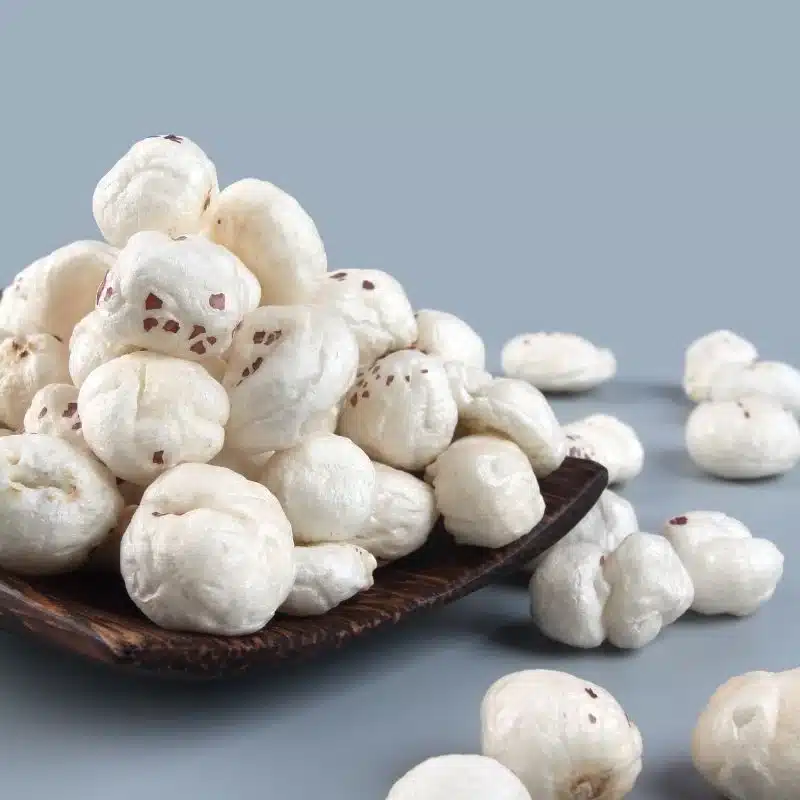Blog
Why is makhana expensive?

Makhana, or phool makhan, is a rare and special food item that’s made from the seeds of Lotus. This plant originated in Asia, but its seeds can be found growing in other parts of the world as well. Makhana is also called lotus seeds or Chinese water chestnuts because it’s shaped similarly to an apple core with a white center that resembles breast milk. It can be eaten raw like other nuts or add them to baked goods for added texture and flavor! The texture of makhana is crunchy on the outside and soft inside—kinda like a cross between an artichoke leaf and an apple core.
Makhana, also known as fox nuts or lotus seeds, has gained immense popularity in the health food industry due to its numerous health benefits. However, many consumers find themselves wondering why this seemingly humble snack comes with a hefty price tag. In this article, we will explore the factors that contribute to the high cost of Makhana and why its purity and quality often justify the expense.
1. Cultivation Challenges
Makhana is harvested from the seeds of the lotus flower, which grows in natural water bodies. Cultivating lotus seeds is a labor-intensive process that involves careful handling to prevent damage to the delicate seeds. Additionally, Makhana cultivation requires specific water conditions, making it a challenging crop to grow. Limited cultivation areas and labor-intensive harvesting contribute to its relatively low production volume, increasing its market value.
2. Hand Harvesting and Processing
Makhana is traditionally hand-harvested by skilled farmers. The seeds are then carefully processed, involving steps like cleaning, drying, and roasting. This meticulous processing ensures the preservation of its natural flavor, texture, and nutritional value. Hand-processing is time-consuming and requires skilled labor, further adding to the production cost.
3. Nutritional Density and Health Benefits
Makhana is valued for its impressive nutritional profile, containing high-quality proteins, fiber, and essential minerals. Its health benefits, including aiding in weight loss, promoting heart health, and supporting digestion, have contributed to its growing demand. As consumers increasingly seek nutrient-dense foods, the market for Makhana has expanded, allowing producers to maintain premium pricing.
4. Limited Shelf Life
Due to its high oil content, Makhana has a limited shelf life compared to other snacks. To maintain its freshness and prevent spoilage, it requires careful storage and packaging. Proper storage conditions, such as airtight containers and cool, dry environments, are essential to preserve its quality, adding to the overall cost.
5. Ethical and Sustainable Practices
Many Makhana producers prioritize ethical and sustainable farming practices. This includes avoiding chemical pesticides and fertilizers, promoting organic farming techniques, and supporting local communities. While these practices are environmentally friendly and support the well-being of farmers, they can increase production costs, thus impacting the final price of Makhana.
6. Rising Demand and Premium Quality
The increasing awareness of Makhana’s health benefits and its popularity among health-conscious consumers have elevated its demand. Premium quality Makhana, often sourced from specific regions known for their superior lotus seeds, commands a higher price. Consumers are willing to pay more for guaranteed purity and high nutritional value.
While the cost of Makhana might seem high, it is important to recognize the meticulous cultivation, labor-intensive harvesting, careful processing, and ethical practices that contribute to its price. As consumers become more health-conscious and seek high-quality, natural foods, the demand for Makhana continues to rise, making it a valuable investment in overall well-being. Understanding the factors behind its expense helps consumers appreciate the efforts and expertise that go into producing this extraordinary and nutritious snack.
What is makhana?
Makhana is a small and round nut that is commonly called fox nut, fox nut or kurkure. It has a soft shell and a white kernel inside. The name of this fruit comes from its shape, which resembles the ears of a fox.
Makhana has been used in traditional medicine for thousands of years to treat diabetes and high blood pressure (hypertension). It also provides many health benefits such as lowering cholesterol levels and preventing cancer cells from growing in your body.
Makhana is rich in protein content compared to other nuts such as almonds or cashews; it contains only about 6% fat per 100g serving size while almonds have about 22% fat content per 100 gram serving size!
Makhana’s taste and nutrition
Makhana is a good source of iron, calcium and fibre. It is also high in protein and low in calories, fat, sodium and gluten.
Why is makhana expensive?
Makhana is a seasonal food, which means it’s only available during certain times of the year. It’s also imported from India, so it costs more to get them here and store them before they sell out. In addition to being expensive because of its limited supply and high demand, makhana is considered a luxury item by many people–so even if you could find it at your local grocery store or farmers market (it may not be there), you may just decide that paying $10 per pound is worth it because you value your health so much!
Makhana has many health benefits: It contains antioxidants that help prevent cancer cells from growing in your body; helps lower cholesterol levels in the blood; improves digestion by helping food move through your digestive tract easier; reduces inflammation caused by arthritis symptoms such as joint pain or stiffness; contains magnesium which helps support healthy bones
The takeaway from this is that makhana is not expensive, but it does have a high price tag. Makhana is an excellent source of protein and fiber, which makes it very healthy to eat. It’s also low in calories and has a low glycemic index, meaning it won’t spike your blood sugar like other foods might do (like white bread).
Makhana is a great source of nutrition and it is also very tasty. It has many health benefits that you can enjoy. However, it’s not cheap. This makes it hard for people to afford this delicious food item even though they want to eat it often.
Here are ten frequently asked questions about why makhana is expensive:
1. What is makhana and why is it considered expensive?
Makhana, also known as fox nuts or lotus seeds, is a popular snack in India and Southeast Asia. It is considered expensive due to its limited availability, labor-intensive processing, and high nutritional value. The demand for makhana has increased in recent years due to its perceived health benefits, which have contributed to its relatively high price tag.
2. What are the health benefits of makhana?
Makhana is a rich source of protein, fiber, and essential minerals like potassium, magnesium, and zinc. It is also low in calories and fat, making it an ideal snack for weight watchers. Makhana is believed to have a range of health benefits, including improving digestion, reducing inflammation, and aiding in weight loss.
3. How is makhana harvested and processed?
Makhana is obtained from the seeds of the lotus plant, which are harvested by hand from the surface of ponds and lakes during the months of August and September. The seeds are then sun-dried and roasted until they pop, creating a crunchy and nutty flavor.
4. Why is makhana more expensive than other snacks?
The cost of producing makhana is higher than that of other snacks due to its labor-intensive harvesting and processing methods. Additionally, makhana is considered a niche product, which limits its availability and drives up its price.
5. Can makhana cause allergies?
While makhana is generally considered safe to eat, some people may have an allergic reaction to it. Individuals with a history of allergies to nuts or seeds should exercise caution when consuming makhana.
6. Is makhana suitable for people with dietary restrictions?
Makhana is a gluten-free and vegan snack, making it suitable for people with dietary restrictions. However, individuals with kidney problems or high potassium levels should consult their doctors before consuming makhana due to its high potassium content.
7. What are the different ways to consume makhana?
Makhana can be consumed as a snack, either roasted or flavored with different spices and seasonings. It can also be used in curries, desserts, and other Indian dishes.
8. How can I store makhana to maintain its freshness?
Makhana should be stored in an airtight container in a cool, dry place to maintain its freshness. It is also recommended to consume it within 2-3 weeks of purchase to ensure its quality.
9. Can makhana be used for weight loss?
Makhana is a low-calorie, high-fiber snack that can aid in weight loss when consumed as part of a balanced diet. It is also believed to reduce hunger pangs and improve satiety, making it an ideal snack for weight watchers.
10. Where can I buy authentic makhana?
Authentic makhana can be purchased from specialty Indian stores or online retailers that specialize in selling Indian snacks and groceries. It is important to read reviews and check the authenticity of the product before making a purchase.



